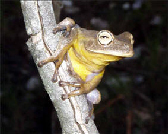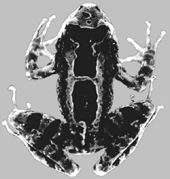Napoli, M.F., 2005. A new
species allied to Hyla circumdata (Anura: Hylidae)
from Serra da Mantiqueira, Southeastern Brazil.
Herpetologica, 61(1):63-69.
|

Hyla caramaschii
|
Abstract:
Hyla circumdata
(Cope, 1870) occurs in subtropical and tropical rain forests,
distributed over mountain ranges of the Brazilian Plateau,
mainly in the Serra do Mar and Serra da Mantiqueira ranges.
Samples of the northern sector of Serra da Mantiqueira
revealed distinctive characters when compared to samples
from the southern sectors of Serra da Mantiqueira and Serra
do Mar, which suggest that the former is a new species. The
new species is characterized mainly by large size (snout–vent
length 57.5–70.0 mm in males; 55.3–67.2 mm in females),
absence of vocal slits in adult males, and a large tympanum.
|
Napoli, M. F. & Cruz, I. C. S.,
2005. The advertisement call of Hyla atlantica
(Anura, Hylidae), with considerations on its taxonomic
status. Arquivos do Museu Nacional,
63(2):1-6.
|
|
Abstract: The
advertisement call of Hyla atlantica is described
upon specimens from the Municipality of Ituberá, Bahia,
Brazil. The call comprises four to eight notes. Call
duration 0.19-0.44s, and note duration 12-22.37ms. Two
spectral bandwidths (harmonics) are distinct. The
lowest-pitched harmonic ranges from 0.68-1.90kHz, and the
highest from 2-3.68kHz. Overall dominant frequencies
0.84-1.28kHz (fundamental frequency), with exception of four
calls (3.25%) in which values reached 2.18-2.53 kHz.
Comparisons of the advertisement calls of H. atlantica
and H. punctata resulted in two different
suppositions in respect to the taxonomic status of the
former. The overall analysis of the literature indicated
that the calls of H. atlantica and H. punctata
from Manaus (Amazonas, Brazil), Santa Cecilia (Ecuador), and
Puerto Almacén (Bolivia) are similar, which does not support
H. atlantica as a valid species. In a complementary
analysis, using recordings of the call of H. punctata
available on commercial digital media from Bolivia and
French Guiana, and another from Maranhão (Brazil),
significant differences between the calls of H. atlantica
and H. punctata were obtained, which lead to the
conclusion that may exist at least three distinct species
involved: H. atlantica from Bahia (Brazil); H.
punctata from northern South America (Manaus/Amazonas
and Maranhão, Brazil; Ecuador; French Guiana; Suriname); and
a third species from Bolivia (type locality of H. p.
rubrolineata), Acre (Brazil), and Chacoan Argentina.
The latter hypothesis is more congruent with the geographic
distribution of the samples analyzed, and also with the
current taxonomic positions of the taxa involved.
|
Napoli, M. F. &
Juncá, F.A. 2006.
A new species of the Bokermannohyla circumdata group
(Amphibia: Anura: Hylidae) from Chapada Diamantina, State of
Bahia, Brazil.
Zootaxa 1244: 57-68.
|

Bokermannohyla diamantina
|
Abstract: A new species of the Bokermannohyla
circumdata group, B. diamantina sp. nov., is
described from Serra dos Barbados, Municipality of Abaíra,
State of Bahia, Brazil. This locality belongs to Chapada
Diamantina, a semiarid region in central Bahia. This is the
first record of a species of the B. circumdata group
from the Brazilian semiarid. Bokermannohyla diamantina
is diagnosed by the medium size (snout-vent length
47.0–51.7 mm in adult specimens); head length 2.8–2.9 times
smaller than snout-vent length; tympanum medium-sized, its
diameter 1.3–1.5 times smaller than eye diameter (tympanum
diameter/snout-vent length 0.07); thigh and tibia lengths
0.48–0.52 and 0.49–0.51 of snout-vent length, respectively;
dorsum medium to blackish brown, with weak transverse dark
brown bars; flanks, anterior, and posterior surfaces of
thighs with dark transverse brown stripes, lacking
additional thin stripes between them; distinct vocal slits
in adult males; advertisement call with 2–4 notes, and
dominant frequency from 0.39–0.56 kHz.
|
Feio, R. N.; Napoli,
M. F. & Caramaschi, U. 2006. Considerações
taxonômicas sobre Thoropa miliaris (Spix, 1824), com
revalidação e redescrição de Thoropa taophora
(Miranda-Ribeiro, 1923) (Amphibia, Anura, Leptodactylidae).
Arquivos do Museu Nacional, Rio de Janeiro,
64(1): 41-60.
|
|

|
Abstract:
Taxonomic considerations on Thoropa miliaris (Spix,
1824), with revalidation and redescription of Thoropa
taophora (Miranda-Ribeiro, 1923) (Amphibia, Anura,
Leptodactylidae). Through the evaluation of the variation of
morphometric and external morphologic characters of
different population samples along its geographical
distribution, Thoropa miliaris (Spix, 1824) is
taxonomically characterized, with designation and
description of a neotype for the species. The same analysis
evidenced that the samples from the coast and part of the
interior of the State of São Paulo are consistently
different from the nominal species. Thoropa taophora
(Miranda-Ribeiro, 1923) is revalidated and redescribed to
designate these populations. The geographic distribution of
both species is presented.
|
Bastazini, C. V., Munduruca, J. V., Rocha, P. L. B. &
Napoli, M. F. 2007.
Which environmental variables
better explain changes in anuran comunity composition? a
case study in the Restinga of Mata de São João, Bahia,
Brazil. Herpetologica 63(4):459-471.
|
|
Abstract:
Most studies
of amphibian communities are restricted to aquatic
environments, which precludes sound descriptions of changes
in composition throughout entire habitats. Moreover, few
works focus on the environmental processes that shape the
composition of these communities, particularly in tropical
ecosystems. In this study, we investigated which
environmental variables were able to predict the main
changes in anuran community composition in a shrub-to-forest
Restinga on the northeastern coastline of Bahia State,
Brazil. In 30 plots (60 3 25 m) along a continuous Restinga
area, we determined, over two consecutive rainy seasons, the
abundances of anuran species and 20 primary environmental
variables. We represented the main environmental gradients
of the Restinga using the first axes derived from a
principal component analysis (PCA) of the matrix of
environmental variables. We represented the main changes in
community composition using a synthetic axis built by
applying the nonmetric multidimensional scaling technique
(NMS) on the matrix of species abundances. We then
evaluated, using a multiple linear regression test, which
environmental gradients, if any, were able to explain
changes in community composition. We recorded 737 anurans,
belonging to 8 families, 17 genera, and 30 species. Five
orthogonal environmental gradients were extracted,
representing ca. 80% of the variance of the matrix of
environmental variables; the first PC represented the
covariation among the amount of leaves in the stratum from 6
to 10 m high, percentage of leaf litter, percentage of
terrestrial bromeliads with direct sunlight, number of
terrestrial bromeliads, and soil moisture. The NMS axis
explained 50% of the variance of the abundance matrix and
ordered the plots through the sequence (1) beach zone, (2)
arboreal vegetation with temporary ponds and/or permanent
lakes, (3) arboreal vegetation with rivers or streams, and
(4) arboreal vegetation without bodies of water. Only PC1,
which represented a shrub-to-forest gradient, was
significantly related to the NMS axis. The change on plant
communities, allied to soil moisture and type of water body,
was the most important environmental factor acting on the
structure of the anuran community herein studied.
|
Cruz, C. A. G.;
Caramaschi, U.; Napoli, M. F. 2007. A new species of
Chiasmocleis (Anura, Microhylidae) from the Atlantic
Rain Forest of northeastern Bahia, Brazil. South American
Journal of Herpetology, 2(1):47-52.
|
 |
Abstract: A
new species of the genus Chiasmocleis is described
from the Reserva Sapiranga, an Atlantic Rain Forest remnant
in the Municipality of Mata de São João, northeastern State
of Bahia, Brazil. This species belongs to the C.
leucosticta group, characterized by well-developed
webbing on feet. Chiasmocleis sapiranga sp. nov. is
diagnosed by having the fingers extensively fringed in males
and only slightly fringed in females, and by the dorsal
region uniformly dark brown and ventral region finely
marbled in brown and pale cream.
|
Ananias,
F.; Modesto, A. D. S.; Mendes, S. C. & Napoli, M. F.
2007. Unusual primitive heteromorphic ZZ/ZW sex chromosomes
in Proceratophrys boiei (Anura, Cycloramphidae,
Alsodinae), with description of C-Band interpopulational
polymorphism. Hereditas 144: 206-212.
|
|
Abstract:
We performed cytogenetic
analyses on specimens from three population samples of
Proceratophrys boiei from southeastern and
northeastern Brazil. We stained chromosomes of mitotic and
meiotic cells with Giemsa, C-banding and Ag-NOR methods. All
specimens of P. boiei presented a karyotype with a
full chromosome complement of 2n=22, metacentric and
submetacentric.We observed the secondary constriction within
the short arm of pair 8, which was in the same position of
the nucleolus organizer region (NOR). NOR heteromorphism was
observed within two specimens from the municipality of Mata
de São João (northeastern Bahia State). The C-banding
evidenced an unusual heterochromatic pattern in the genome
of P. boiei. In the southernmost population samples
(São Paulo State), we observed large blocks of
heterochromatin in the centromeric regions of all
chromosomes, whereas the northernmost samples (Bahia State)
presented a small amount of constitutive heterochromatin. We
suppose that this geographic variation in heterochromatin
quantities could be due to heterochromatinization of some
chromosome regions in the genome of the São Paulo samples.
Furthermore, females from São Paulo presented, within
chromosome pair 1 from C-banded karyotypes, one homologous
chromosome almost
heterochromatic, whereas males had heterochromatin
restricted to the centromeric region. This unusual
heterochromatic arrangement led us to assume that P.
boiei owns a ZZ/ZW type of sexual determination system.
This finding is very important, as this is the first record
of ZZ/ZW sex chromosomes within Cycloramphidae. We believe
that the cytogenetic differences found between southeastern
and northeastern Brazilian population samples of P. boiei
strongly supports the existence of a species complex under
the name P. boiei, and the requirement of taxonomic
and systematic reviews by morphological, bioacoustical,
molecular, and cytogenetic data could define this taxonomic
issue in the future.
|




